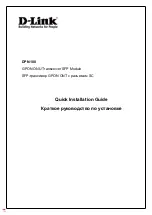
Product Overview and Specifications
11
Hardware Reference Manual – DXLink™ Twisted Pair 4K Transmitters/Receivers
Receivers
NOTE:
If a DVI-D signal is used (via a DVI-to-HDMI cable adapter), the advanced audio support from HDMI will not be available.
DXLink Receivers Front View
NOTE:
DXLink Receivers have a DIP switch on the bottom; for details, see page 13.
The following components are located on the front of the Receivers (left to right):
Power LED
–
Indicates when the Receiver is powered on.
Video and Audio LEDs
–
Indicate the presence of video and embedded audio signals through the Receiver.
Scaling button and LEDs
–
Use the Scaling button to select one of the 3 scaling options: Bypass, Auto (default), or Manual.
For information on using the Scaling button and options for persisting the Scaling Mode, see page 34.
Program port
–
This port is a USB mini-B connector.
IR LEDs
– RX LEDs indicate active IR communication.
232 (RS-232) LEDs
– RX LEDs indicate active serial communication.
NetLinx LEDs
– Link/Act LED indicates network communication activity. The Status LED indicates unit status.
CEC LED
– CEC is not currently supported.
USB LED
– When illuminated, the LED indicates that the USB port connection has been established (for details, see
ID Pushbutton
– Places the Receiver in ID Mode for setting the NetLinx ID (device only) and provides additional
functionality, such as placing the device in Static IP Mode or DHCP Mode.
Receiver Module LEDs
* When the output HDMI cable is disconnected from the Receiver or if no EDID can be found on the destination device, the last used
Scaling Mode LED will be ON. In either case, the Receiver will continue to hold its output resolution to the last known preferred
resolution until a power cycle or reconnection of a sink with a valid EDID. On power up without a valid EDID, the default preferred
output resolution presented will be 3840x2160,30Hz until a different EDID is detected.
NOTE:
For detailed behavior of the NetLinx Link/Act and Status LEDs on the module’s front, see page 35. For detailed behavior of the
RJ-45 connectors’ LEDs on the module’s rear, see page 28.
FIG. 3
DXLink Receiver front view (DX-RX-4K shown)
DXLink Receiver Indicator LEDs
LED
Normal Display
Indicates
Power
Green
Power is applied to the Receiver
Video
Green
A video signal is present through the Receiver
Audio
Green
An embedded audio signal is present through the Receiver
Scaling:
– Bypass
– Auto
– Manual
One LED is green
The other two are off
The Receiver is in one of the three modes for scaling
• At initial power up, the Receiver defaults to the Auto scaling option*
• Pressing the Scaling button cycles the module through the options: Bypass, Auto, and
Manual
• If Bypass is solid and Auto is flashing, then the RX is trying to read EDID from the sink
IR TX
Red
IR TX active communication
IR RX
Yellow
IR RX active communication
Serial TX
Red
Serial TX active communication
Serial RX
Yellow
Serial RX active communication
NetLinx Link/Act Green
Active LAN connection to an AMX Network (Blinking = #3 Toggle OFF)
Video and Audio LEDs
Power LED
CEC LED
IR LEDs
232 (serial) LEDs
NetLinx LEDs
USB LED
ID Pushbutton
Scaling LEDs
Program port












































